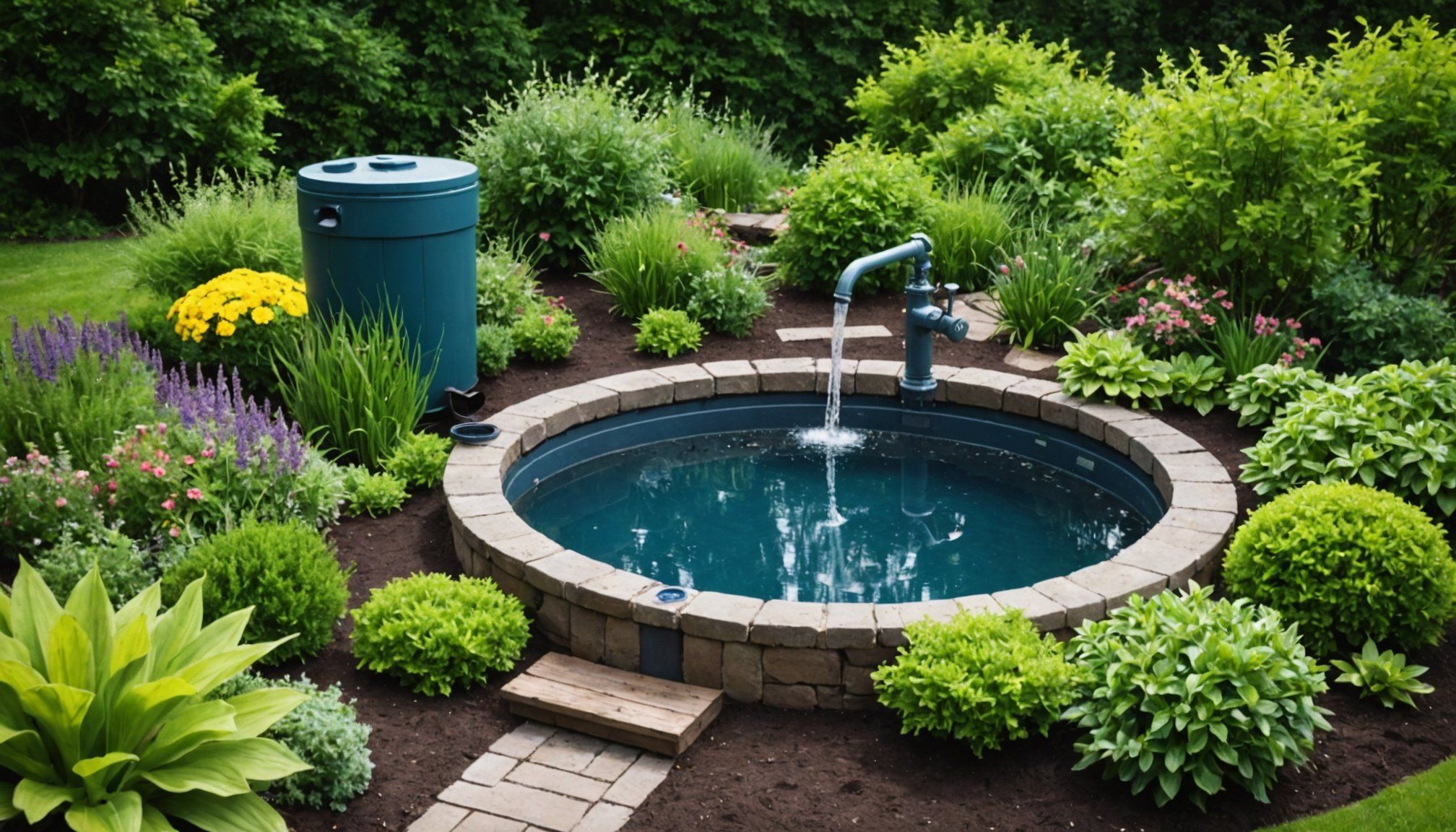Transform Your Garden with an Eye-Catching Water Recycling System: A Comprehensive Step-by-Step Guide to Water Recycling in Your Garden
In today’s world, where water conservation is more crucial than ever, incorporating a water recycling system into your garden can be a game-changer. Not only does it help reduce your water bills and strain on local water resources, but it also promotes a more sustainable and eco-friendly gardening practice. In this guide, we will walk you through the process of setting up and maintaining a water recycling system, whether you’re using greywater or rainwater, to make your garden greener and more sustainable.
Understanding Grey Water Recycling Systems
Greywater is the wastewater generated from washing machines, showers, and bathroom sinks, which is less contaminated than blackwater from toilets and kitchen sinks. Greywater recycling systems are designed to treat and reuse this water for non-potable purposes, making them an excellent addition to your home and garden.
Topic to read : Elevate Your Outdoor Yoga Haven: Harmonize Your Peaceful Retreat with Nature’s Tranquility
Collection
The first step in greywater recycling is to collect the wastewater. This is typically done using a separate plumbing system that diverts greywater from its sources to a holding tank. Ensure that the collection system is properly installed to avoid any contamination with blackwater[1].
Filtration
Once collected, the greywater needs to be filtered to remove solid particles and debris. The filtration process can include physical, biological, and chemical treatments to remove contaminants like hair, soap, and bacteria. This step is crucial to make the water safe for use in your garden[1].
Also to discover : Transform your bathroom: the definitive guide to choosing perfect water-resistant wallpaper
Distribution
After filtration, the treated greywater is stored in a separate tank until it is ready to be reused. It can be distributed through a separate plumbing system or using a pump to irrigate your plants, flush toilets, or other non-potable purposes. Make sure the distribution system is well-designed to avoid any backflow into the potable water supply[1].
Benefits of Grey Water Recycling Systems
- Reduced Water Consumption: Greywater recycling can reduce household water consumption by up to 50%, leading to lower water bills and reduced strain on local water resources.
- Improved Soil Quality: Greywater contains nutrients beneficial for plants, which can improve soil quality when used for irrigation.
- Reduced Strain on Septic Systems: By diverting greywater from septic systems, you can extend their lifespan and reduce the need for costly repairs.
- Improved Sustainability: Promoting the reuse of resources, greywater recycling systems contribute to a more sustainable future[1].
Rainwater Harvesting Systems: An Alternative Approach
If you’re not keen on using greywater or if it’s not feasible in your area, rainwater harvesting is another excellent option. Here’s how you can set up a rainwater harvesting system:
Collection
Rainwater harvesting typically involves collecting water from your roof and downspouts. This can be done using a preconfigured system like the RainFlo 1100AGS, which includes all necessary components such as a tank, pump, and filtration system. Simply connect the downspout to the tank and ensure all fittings are properly installed[2].
Filtration
The collected rainwater needs to be filtered to remove debris and contaminants. A floating filter and first flush diverter are often included in preconfigured systems to ensure the water is clean and free from initial roof runoff contaminants[2].
Distribution
The filtered rainwater is then stored in a tank and can be distributed using a pump to irrigate your garden, water your plants, or even flush toilets. Ensure the distribution system is designed to meet your specific needs, whether it’s for residential or commercial use[2].
Designing Your Water Recycling System
When designing your water recycling system, several factors need to be considered to ensure it is efficient and effective.
Assess Your Needs
Determine how much water you need to recycle and for what purposes. If you have a large garden, you may need a more extensive system. For smaller gardens, a simpler setup might suffice.
Choose the Right Components
Select components that are durable and suitable for your specific needs. For example, if you’re using a rainwater harvesting system, a high-quality tank and pump are essential. For greywater systems, ensure the filtration system is robust enough to handle the contaminants[1][2].
Consider Local Regulations
Check local regulations regarding rainwater harvesting and greywater recycling. Some areas have specific rules and restrictions, so it’s important to comply to avoid any legal issues[4].
Practical Tips for Implementing Your System
Here are some practical tips to help you implement and maintain your water recycling system:
- Regular Maintenance: Regularly check and maintain your system to ensure it is functioning correctly. This includes cleaning filters, checking for leaks, and ensuring the distribution system is working as intended.
- Use Recycled Materials: Where possible, use recycled materials for your system. This can include using old barrels or tanks for storage.
- Monitor Water Quality: Regularly test the water quality to ensure it is safe for use in your garden. This is particularly important for greywater systems.
- Educate Yourself: Take the time to learn about the different types of systems and their requirements. This will help you make informed decisions and troubleshoot any issues that arise[1][2][4].
Examples and Anecdotes: Real-Life Applications
Rainwater Harvesting in Drought-Prone Areas
In areas like Texas, where droughts are common, innovative rainwater harvesting systems have been developed. For instance, [SuburbanBiology] built a system that collects rainwater from the street instead of just the roof, using a custom sump pump to deliver the water to the landscaping. This approach not only helps maintain a lush garden but also reduces stormwater runoff, benefiting the surrounding environment[4].
Greywater Recycling in Residential Homes
In Sydney, Australia, Eco-Septic has helped numerous homeowners install greywater recycling systems. These systems have significantly reduced water consumption and improved soil quality, making gardening more sustainable and cost-effective[1].
Comparative Analysis: Greywater vs Rainwater Harvesting
Here is a comparative analysis of greywater recycling and rainwater harvesting systems to help you decide which might be best for your garden:
| Feature | Greywater Recycling | Rainwater Harvesting |
|---|---|---|
| Source | Wastewater from washing machines, showers, bathroom sinks | Rainwater collected from roofs and downspouts |
| Treatment | Requires filtration and treatment to remove contaminants | Requires filtration to remove debris and contaminants |
| Use | Non-potable purposes like irrigation, toilet flushing | Non-potable purposes like irrigation, toilet flushing |
| Benefits | Reduces strain on septic systems, improves soil quality | Reduces water bills, promotes sustainable gardening |
| Complexity | More complex due to the need for separate plumbing and filtration | Relatively simpler, especially with preconfigured systems |
| Cost | Can be more expensive due to the need for advanced filtration | Can be cost-effective, especially with DIY setups |
| Maintenance | Requires regular maintenance to ensure system integrity | Requires regular maintenance to ensure system integrity |
Integrating Your System with Other Gardening Practices
To maximize the benefits of your water recycling system, consider integrating it with other eco-friendly gardening practices.
Xeriscaping
Xeriscaping involves using native plants, mulch, rocks, and drip irrigation systems to limit water usage. Combining this with a rainwater harvesting system can create a highly efficient and sustainable gardening setup. For example, using drip irrigation ensures that each drop of water reaches the roots of your plants, minimizing evaporation and runoff[3].
Aquaponics
Aquaponics is a closed-loop system that combines fish farming with plant cultivation. By using recycled water in an aquaponics system, you can create a highly sustainable and productive garden. For instance, the media-based aquaponics system uses beneficial bacteria to break down fish waste into nutrients for plants, eliminating the need for chemical fertilizers[5].: Making Your Garden Green and Sustainable
Transforming your garden with a water recycling system is not just about saving water; it’s about creating a sustainable and eco-friendly outdoor space. Whether you choose to use greywater or rainwater, the benefits are numerous. Here are some final tips to keep in mind:
- Make Sure It’s Legal: Always check local regulations before setting up your system.
- Use Eco-Friendly Materials: Opt for recycled materials and sustainable components.
- Educate Yourself: Learn about the different types of systems and their maintenance requirements.
- Monitor and Adjust: Regularly test water quality and adjust your system as needed.
By following these steps and tips, you can create a beautiful, sustainable garden that not only saves you money but also contributes to a greener future.
Additional Tips for General Gardening and Lawn Care
Here are some additional tips to enhance your gardening and lawn care practices:
- Use Drip Irrigation: Shift to drip irrigation to minimize water waste and ensure each drop reaches the roots of your plants.
- Choose Drought-Tolerant Plants: Select plants that are native to your region or drought-tolerant to reduce water consumption.
- Mulch Your Soil: Mulching helps retain soil moisture, reduces evaporation, and suppresses weeds.
- Use Compost: Composting can improve soil quality and reduce the need for chemical fertilizers.
By integrating these practices with your water recycling system, you can create a thriving, sustainable garden that is both beautiful and eco-friendly.
In the words of a seasoned gardener, “Water recycling is not just about saving water; it’s about creating a sustainable ecosystem that benefits both your garden and the environment. With the right system and practices, you can make your garden green, vibrant, and sustainable for years to come.”

